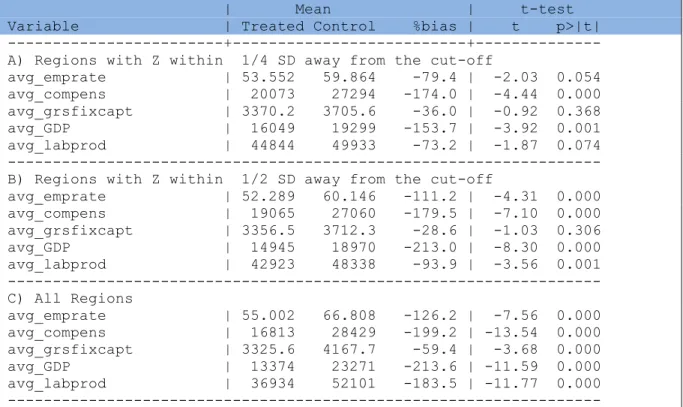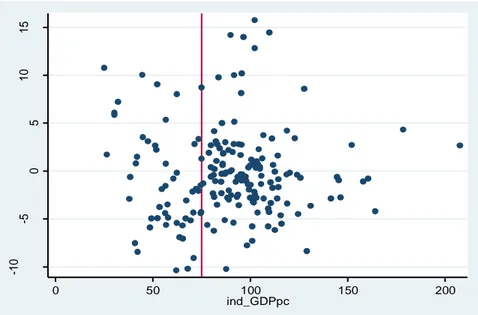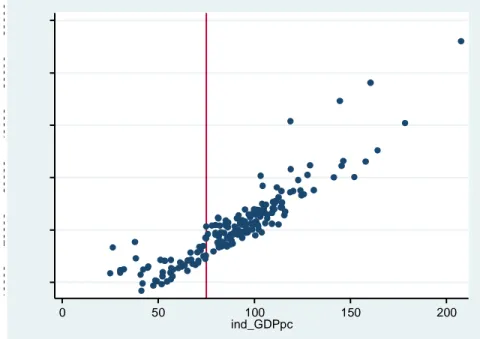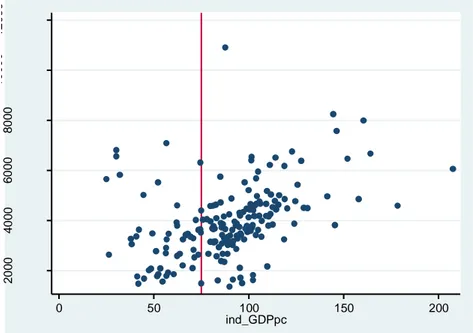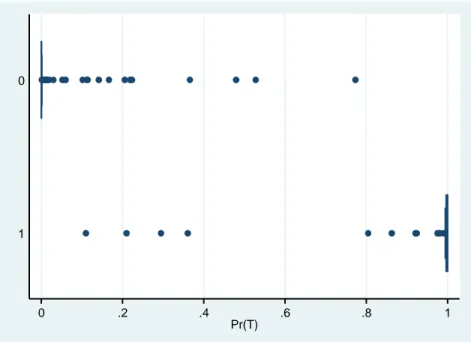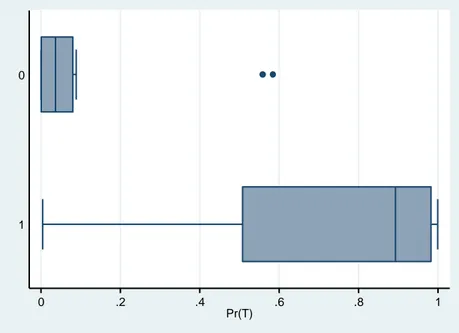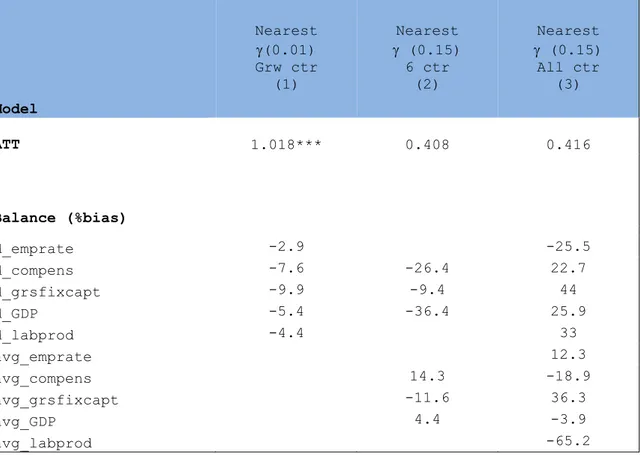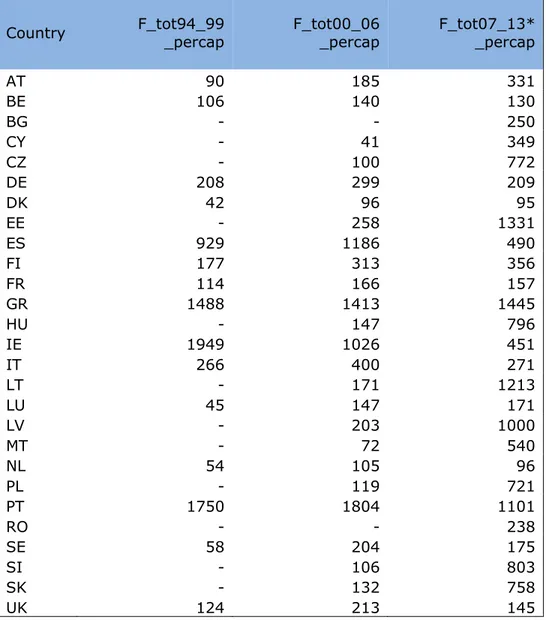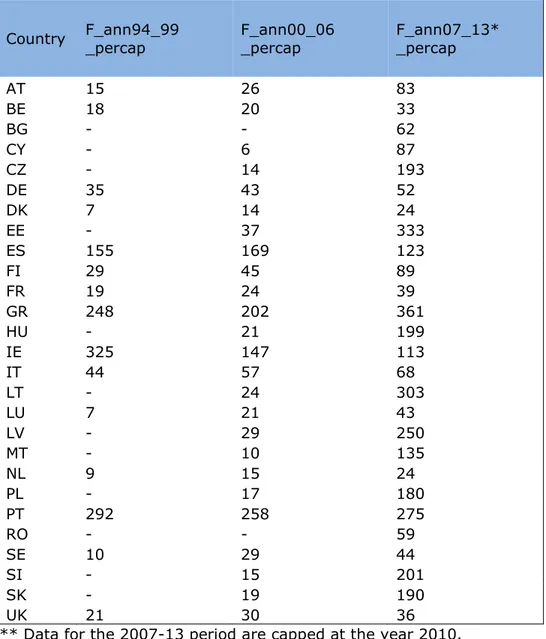March 2016 Authors:
The impact of varying per capita
intensities of EU Funds on
regional growth: Estimating dose
response treatment effects
through statistical matching
FINAL REPORT
Work package 14d:
Propensity score matching
Ex post evaluation of Cohesion Policy programmes
2007-2013, focusing on the European Regional
Development Fund (ERDF) and the Cohesion Fund (CF)
April 2016
EUROPEAN COMMISSION
Directorate-General for Regional and Urban Policy Directorate A1 — Policy coordination
Unit A1.B2 — Evaluation and European Semester Contact: Kai Stryczynski
E-mail: [email protected] European Commission
Directorate-General for Regional and Urban Policy
2016 EN
The impact of varying per capita
intensities of EU Funds on
regional growth: Estimating dose
response treatment effects
through statistical matching
FINAL REPORT
Work package 14d:
Propensity score matching
Ex post evaluation of Cohesion Policy programmes
2007-2013, focusing on the European Regional
Development Fund (ERDF) and the Cohesion Fund (CF)
LEGAL NOTICE
This document has been prepared for the European Commission however it reflects the views only of the authors, and the Commission cannot be held responsible for any use which may be made of the information contained therein.
More information on the European Union is available on the Internet (http://www.europa.eu).
Luxembourg: Publications Office of the European Union, 2016
ISBN 978-92-79-58513-5 doi: 10.2776/256991
© European Union, 2016
Reproduction is authorised provided the source is acknowledged.
Europe Direct is a service to help you find answers
to your questions about the European Union.
Freephone number (*):
00 800 6 7 8 9 10 11
(*) The information given is free, as are most calls (though some operators, phone boxes or hotels may charge you).
3
Table of Contents
Executive Summary ... 7
PART I ... 8
1.
RDD vs Matching for Regional-Level CIEs of EU Funds (EUF) ... 8
2.
Data (Task 1) ... 10
3.
Caveats and limitations of the data (Task 1) ... 11
4.
Sample sizes and descriptive statistics (Task 1) ... 12
4.1
Sample sizes of NUTS2 regions available for the analysis ... 12
4.2
Descriptive statistics on the balance of the pre-intervention covariates (X) between Obj.1 and
non-Obj.1 regions ... 13
5.
Methods: Propensity Score Matching estimation ... 22
5.1
Radius Matching estimators ... 22
5.2
Nearest Available Caliper Matching ... 23
5.3
Kernel Matching ... 24
5.4
PS estimation and common support ... 24
6.
Summary of the results (Task 1) ... 30
7.
Concluding remarks (Task 1) ... 34
PART II ... 35
8.
Data (Tasks 2-3) ... 35
8.1
Outcome variables (Y) ... 35
8.2
EU Funds (EUF) per-capita intensities ... 35
8.3
Control variables (X) ... 36
9.
Caveats and limitations of the data (Tasks 2-3) ... 38
10.
Sample sizes and descriptive statistics (Tasks 2-3) ... 40
10.1
Descriptive statistics on the value of the EU Funds (EUF) across the three programming periods
1994-99; 2000-06; 2007-13 (EU27) ... 40
10.2
EU Funds (EUF) in the EU-27 regions sorted by Objective1/Convergence Obj. status (years
1994-2010) ... 44
10.3
Descriptive statistics on the outcome variables of the analysis: GVA, gross-fixed capital formation
and employment rate ... 45
11.
Dynamic Propensity Score Matching (PSM) models for estimating the average impacts of the
highest intensity of the EU Funds (EUF) in the Objective 1/Convergence Obj. regions ... 52
12.
Generalised Propensity Score (GPS) and Propensity Score Matching (PSM) models for estimating
the impact of continuous and multiple categorical treatment intensities ... 53
4
13.
Summary of the results (Tasks 2 and 3) ... 60
14.
Concluding remarks (Tasks 2 and 3) ... 63
References ... 65
Annex 1: Task 1 - Technical Appendix ... 66
5
Table of figures
Table 1 : Sample sizes of NUTS2 regions by Eligibility Status (T=1 Obj.1; T=0 non-Obj.1) ... 13
Table 2 : Sample sizes of NUTS2 regions within ¼ SD from cut-off of Z (67.85% <Z >82.15%) ... 13
Table 3 : Sample sizes of NUTS2 regions within 1/2 SD from cut-off of Z (60.70% <Z >89.30%) ... 13
Table 4 : Pre-intervention differences in Xgrw between Obj.1 (treated) and non-Obj.1 regions (control) .... 14
Table 5 : Pre-intervention differences in Xlev between Obj.1 (treated) and non-Obj.1 regions (control) ... 15
Table 6 : Results from the PS Radius Matching estimators (preferred specifications with the best balancing
of the control variables) ... 30
Table 7 : Results from the PS Nearest Available estimators with Caliper (preferred specifications) ... 32
Table 8 : Results from the PS Kernel Matching estimators, Gaussian with bandwidth (preferred
specifications) ... 33
Table 9 : Total EU Funds (1=1 Million €) by country and by period ... 40
Table 10 : Total per-capita EU Funds (1=1 € / per capita) by country and by Programming period ... 41
Table 11 : Average annual per-capita EU Funds (1=1 € / per capita / per year) by country and by
Programming period ... 42
Table 12 : Pooled distribution of the NUTS2 annual per-capita EU Fund intensities in the three
programming periods (1=1€ / per capita / per year) ... 43
Table 13 : Total sum of EU Funds received by NUTS2 regions over the whole 1994-2010 period ... 44
Table 14 : Average intensity of the EU Funds (EUF) by Obj.1/Convergence Obj status ... 45
Table 15 : NUTS2 regions sorted by categories of intensities of the EU Funds (EUF) ... 45
Table 16 : Annual average changes of GVA, gross fixed capital formation and employment rate by categories
of EU Fund (EUF) intensities. Programming period 1994-99 ... 46
Table 17 : Annual average changes of GVA, gross fixed capital formation and employment rate by categories
of EU Fund (EUF) intensities. Programming period 2000-06 ... 47
Table 18 : Annual average changes of GVA, Gross fixed capital formation and Employment rate by
categories of EU Fund intensities. Programming period 2007-13(*) ... 47
Table 19 : Average annual growth by Obj.1/Conv. Obj status ... 51
Table 20 : Variable specifications of the Dynamic PSM model with binary treatment intensity (EU-27 regions,
1994-2013 periods) ... 52
Table 21 : Variable specifications of Models I -II ... 58
Table 22 : Variable specifications of Models III-IV ... 59
Table 23 : Impacts of EU Funds (EUF) on GVA growth. EU-27, 1994-2011 ... 60
Table 24 : Impacts of EU Funds (EUF) on Gross fixed capital formation growth. EU-27, 1994-2011 ... 61
Table 25 : Impacts of EU Funds (EUF) on employment rate changes. EU-27, 1994-2011 ... 62
Figure 1 : Pre-intervention annual % change in the employment rate (1=p.p.) plotted against values of Z
(per-capita GDP in 1988-90 in terms of % of EU mean) ... 16
Figure 2 : Pre-intervention annual % growth in GDP per-capita (1=p.p.) plotted against values of Z
(per-capita GDP level in 1988-90 in terms of % of EU mean) ... 16
Figure 3 : Pre-intervention annual % change in worker compensation (1=p.p.) plotted against values of Z
(per-capita GDP in 1988-90 in terms of % of EU mean) ... 17
Figure 4 : Pre-intervention annual % growth in per-capita fixed capital formation (1=p.p.) plotted against
values of Z (per-capita GDP level in 1988-90 in terms of % of EU mean) ... 17
6
Figure 5 : Pre-intervention annual % growth (1=1 p.p.) in labour productivity (GDP per-worker) plotted
against values of Z (per-capita GDP level in 1988-90 in terms of % of EU mean) ... 18
Figure 6 : Pre-intervention average level of employment rate (1=1%) plotted against values of Z (per-capita
GDP in 1988-90 in terms of % of EU mean) ... 19
Figure 7 : Pre-intervention average level of GDP per-capita (1=EUR) plotted against values of Z (per-capita
GDP level in 1988-90 in terms of % of EU mean) ... 19
Figure 8 : Pre-intervention average level of worker compensation (1=EUR) plotted against values of Z
(per-capita GDP in 1988-90 in terms of % of EU mean) ... 20
Figure 9 : Pre-intervention average level of per-capita fixed capital formation (1=EUR) plotted against values
of Z (per-capita GDP level in 1988-90 in terms of % of EU mean) ... 20
Figure 10 : Pre-intervention average level of labour productivity (GDP per-worker, 1=1 EUR) plotted against
values of Z (per-capita GDP level in 1988-90 in terms of % of EU mean) ... 21
Figure 11 : Boxplots of the PS distributions based on Xgrw (Growth-trends controls) [All Regions] ... 25
Figure 12 : Boxplots of the PS distributions based on three Xgrw (Growth-trend controls) and three Xlev
(Average-level controls). [All Regions] ... 26
Figure 13 : Boxplots of the PS distributions based on all Xgrw (Growth-trend controls) and Xlev
(Average-level controls). [All Regions] ... 26
Figure 14 : Boxplots of the PS distributions based on Xgrw (Growth-trends controls). [Regions close to the
cut-off of eligibility: Z within 1/4 SD away from the cut-off] ... 27
Figure 15 : Boxplots of the PS distributions based on three Xgrw (Growth-trend controls) and three Xlev
(Average-level controls). [Regions close to the cut-off of eligibility: Z within 1/4 SD away from the cut-off]
... 28
Figure 16 : Boxplots of the PS distributions based on all Xgrw (Growth-trend controls) and Xlev
(Average-level controls) ... 28
Figure 17: Avg. annual amount of per-capita EUF plotted against the avg. annual growth rate of per-capita
GVA, GFCF, and annual change of employment rate. Programming period 1994-99 ... 48
Figure 18 : Avg. annual amount of per-capita EUF plotted against the avg. annual growth rate of per-capita
GVA, GFCF, and annual change of employment rate. Programming period 2000-06 ... 49
Figure 19 : Avg. annual amount of per-capita EUF plotted against the avg. annual growth rate of per-capita
GVA, GFCF, and annual change of employment rate. Programming period 2007-13(*) ... 50
Figure 20 : Causality chain, from EU funds to desirable regional growth outcomes ... 53
Figure 21 : Trade-off between model dependence and impact identification power ... 54
7
Summary
As part of the Ex post evaluation of the 2007-2013 programming period of the European
Cohesion Policy this report deals with the impact of the varying per capita intensities of EU
funds on regional growth. The works was separated in three tasks. The first one focuses on the
analysis of how the intensity variation of EU structural funds affected regional growth in the
EU-15 regions in the 1994-2006 period. Task 2 deals with the impact of EU cohesion policy on
regional growth in the EU-27 regions. Task 3 is wider because it tackles the analysis of
cohesion policy effects for all European countries, considering data up to 2013. Thanks to
statistical methods impacts are estimated. The tasks involved using a counterfactual impact
evaluation design, implementing with propensity score matching (PSM) and generalized
propensity score matching (GPSM).
As concerns the Task1 of this project, there were two main objectives of the analysis. A)
Compare results obtained with a PSM approach to those from earlier RDD analysis research
(Pellegrini et al. 2013 and Becker et al. 2013) to highlight lessons that can be learned on the
data availability scenarios that make preferable to use of one method as supposed to the
other. B). Estimate different impacts for different levels of the per capita intensity of the EUF.
As mentioned in the technical offer, objective B) of the analysis can be achieved by
operationalizing the intensity level of the EUF either dichotomously (as implemented in
Pellegrini et al 2013) or with multiple categories of intensity levels (in discrete or continuous
terms, as implemented, at the NUTS3 level, in Becker et al. 2013). To enhance comparability
with the RDD work package, and because of serious reliability issues with the NUTS3 level
data, it was agreed with DG-regio to use NUTS2 level as the units of observation of the
analysis, instead of the NUTS3 level used by in Becker et al. 2013. Because of the choice to
focus on NUTS2 regions as units of observation, the overall sample size of the regions with
comparable pre-intervention characteristics is not large enough (at the EU15 level for the
1994-2006 period) to allow statistically significant estimations of a continuous or categorical
dose-response function. For this reason the Task 1 analyses presented in this report is
implemented entirely within the framework of the dichotomous difference in the degree of
intensity of the EUF adopted in Pellegrini et al 2013 (i.e. a binary treatment status variables
that distinguishes the higher per capita intensity of the EUF related with “Obj.1”/“Convergence
Obj” eligibility from the lower per-capita intensity related with the “non-Obj.1/Convergence
Obj.1 eligibility”). Thus, as indicated in the technical offer, the actual data availability scenario
and sample size considerations dictated the choice of the exact model that was used in the
Task 1 analysis.
Generalised Propensity Score Matching and propensity score matching estimators with multiple
categorical treatment status variables for the different intensities of the EUF were instead
applied to the analysis for the Tasks 2 and 3 of this projects. These tasks involve estimating
how varying per capita intensity of EUF affected regional growth, extending the analysis of
Task 1 to include the larger sample of EU-27 regions over the period 1994-2013 and
considering a larger number of outcome variables to include, employment growth and growth
of (per capita) gross fixed capital formation, in addition to the per capita regional growth of
GDP used in Task 1
1.
1 As mentioned in the technical offer, the list of outcome variables used for the analysis has been
determined in agreement with DG-Regio based on the actual data availability for the entire list of NUTS2 regions considered in the analysis.
8
PART I
1.
RDD vs Matching for Regional-Level CIEs of EU Funds (EUF)
When adopting RDD for regional-level CIEs of structural and cohesion fund programmes, the
following considerations apply:
• The units of observation for the analysis (i.e. the EU regions) did not self-selected into
applicants and non-applicant for obtaining the former Obj.1 / Convergence Obj status:
such eligibility was based, by the most part on the GNI in PPS recorded by Eurostat. For
this reason, no obvious advantage of RDD versus other CIE methods exist due to the fact
that in RDD the treated units can be compared only with untreated units with the same
initial desire to be treated (while, with other CIE methods, the treated units can be
potentially compared with a general population of non-treated units, regardless of whether
or not they participated into the program application process). Thus applying RRD versus
other CIE methods does not guarantee any better controlling of the unobservable
confounding factors (i.e factors affecting the outcome variable a part from the treatment)
leading to the same desire to be treated.
• In set ups suitable for RDD, the more the forcing variable (determining the treatment
status of the units of observations) is a factor with a weak influence on the outcome
variable Y of the analysis (i.e. a “non-dominant” forcing variable), the more the treatment
assignment process mimic an actual randomization also away from the cut-off point. This
bears an important consequence: The more the forcing variable does not constitute a
“dominant” confounding factor, the larger is the band across the cut-off point in which
conditions similar to a randomized experiment apply.
• Since RDD mimics a block randomization within the neighbourhoods of the cut-off point, in
the presence of small samples and of a “non-dominant” forcing variable, it has to checked
whether or not the sample of treated and non-treated units in the neighbourhood of the
cut-off point are indeed balanced with regards to the other relevant confounding factors
(different from the forcing variable). As widely discussed in the literature, this is common
wisdom in the field of randomized experiments: with small samples, unbalanced
compositions can happen and the randomization process has to be repeated or
implemented as block randomization with regards to all the major confounding factors.
• In the presence of small samples, the more “dominant” is the forcing variable, the less it is
necessary to check whether or not the treated and non-treated units in the neighbourhood
of the cut-off are balanced with regard to other confounding factors (this is because similar
levels of a “dominant” forcing variable ensure per-se an overall balance between treated
and non-treated units even in the presence of small samples). When the sample size is
small, the more the forcing variable is a weak confounding factor (“non-dominant”), the
more it has to checked whether or not the treated and non-treated units in the
neighbourhood of the cut-off are indeed balanced with regard to the actual major
confounding factors (which are different from the forcing variable)
In the case of the EU regions, for the 1994-1999 period, the forcing variable to determine
Obj.1 eligibility was the per-capita GNI in terms of PPS recorded by Eurostat in 1988-1990 ,
which is almost 6 years before the start of the implementation of any actual subsidized Ob.1
project. Similar large temporal gaps were in existence also for the 2000-06 and 2007-13
programming periods, with the eligibility to the higher intensities of EU funds –EUF- (i.e.
9
Objective 1/Convergence Objective area eligibility) based on a forcing variable measured in
1994-96 and 2000-02 respectively. Because of such large temporal gaps and because the
forcing variable measures GDP levels while the outcome variables of the analysis are in terms
of regional growth, it can be deemed that the forcing variable is not a confounding factor that
capture all the relevant regional characteristics that may affect the outcome variables Y used in
the analysis.
Moreover, the sample size of the regions that can be found near the cut-off is very small. Thus,
in light of the arguments discussed above, the treated and non-treated units positioned only
sharply in the neighbourhood of the cut-off are guaranteed to be balanced only with respect to
the forcing variable. Because of the small sample size of the regions in the neighbourhood of
such cut-off, no guarantee is offered with regard of the actual balancing of other important
regional characteristic that influence the outcome Y (in the same way as no balancing is
guaranteed with small samples even with actual randomization).
Thus, with small sample sizes, forcing the comparison to only the regions sharply across the
cut-off point (compared to other CIE methods such as matching) may prevent balancing to
occur with respect to the other important regional characteristics that are important risk
factors for selection bias. In other word, enlarging the neighbourhood across the cut-off of the
forcing variable and ensuring statistical matching between treated and non-treated regions,
may achieve a better overall balancing of all the confounding factors compared to a standard
sharp RDD design. If the forcing variable has the same (or lower) importance as a
confounding factor as other regional characteristics, thus, a best overall balancing between
treated and non-treated regions could be achieved ensuring a good matching of all confounding
factors (i.e. using matching estimators), rather than with standard RDD in which an exact
matching occurs only for the forcing variable and (due to the small sample size) no guarantee
is offered with regard to the actual balancing of other important confounding factors.
10
2.
Data (Task 1)
The sources of the data used in the analysis are as follows:
• Outcome variable (Y): As mentioned in the ToR and in the Technical Offer, to enhance
result comparability, the analysis exploits the same GDP data used in the RDD study of
Pellegrini et. al (2012). Such GDP data were made available to the analysis directly by the
authors of that study and the sources they mentioned for the data are DG-Regio for
1995-1999 and Eurostat for the period 2000-2006. The outcome variable used for the analysis is
operationalized as the average per-capita annual GDP growth;
• Treatment status variable (T): based on the figures from DG-Regio on the EUF
allocated at the NUTS2 level, the different per-capita intensity of EUF has been coded
dichotomously in the following way:
T
i=1 if a NUTS2 i has the additional per-capita EUF availability typically associated with
Obj1 (convergence Obj.) eligibility (“hard financed regions”). The threshold for
operationalizing such “hard financed” regions is, following Pellegrini et al. (2013)
a minimum total value of EUF of 1960 Euro per head
2.
T
i=0 if a a NUTS2 i does not have the additional per-capita EUF associated with Obj1
(convergence Obj.) eligibility (“soft financed regions”);
• Control variables (X): the control variables used in the analysis to ensure good
balancing between the treatment (T
i=1) and the comparison group (T
i=0) were
constructed based on the following 1991-1994 yearly data provided at the NUTS2 level by
Cambridge Econometrics:
o GDP;
o employment rate;
o per capita worker compensation;
o gross fixed capital formation;
o labour productivity (GDP per worker).
These yearly NUTS2 data were used to operationalize two sets of control variables:
X
grw= set of yearly growth rates of the control variables X, operationalized as
yearly percentage changes;
X
lev= set of average levels of the control variables X, operationalized as yearly
average level of X over the period 1991-1994;
• Forcing variable (Z): for the purpose of comparing the PSM results with those of the
RDD analysis, the Obj.1 area eligibility variable (Z) was also considered in the analysis.
Such variable (Z), referred to as the “forcing variable” is the average per capita GDP of the
NUTS2 regions during the 1988-1990 period, in term of purchasing power standards (PPS).
2 To enhance result comparability, we adopted such dichotomous operationalization of the treatment
status variable based on the same data on the regional EU funds allocation used in Pellegrini et. al 2013. The data that were provided to us for the analysis did not include the exact figures of the 1995-2006 EU funds expenditures sorted by NUTS2 regions. Further details on the matter can be found in Pellegrini et. al 2013.
11
3.
Caveats and limitations of the data (Task 1)
The data availability scenario described in the previous section poses the following limitations
to the analysis:
•
The pre-intervention control variables X available for the analysis are measured in the
1991-1994 period which is right before the beginning of the 1995-2006 period of
observation of the EUF expenditures under evaluation. This solution is standard practice in
the literature and it is adopted, for example, in the Generalized Propensity Score –GPS-
study of Backer et al. (2013). However, a large group of NUTS2 regions of Spain and
southern Italy, five NUTS2 regions of France (Corsica and the outer territories) in addition
of the whole group of NUTS2 of Greece and Ireland received Obj.1 EUF assistance from the
1989-1993 programming period that could have potentially affected the GDP growth in the
1991-1994 period. The Obj.1 EUF assistance for the 1989-1993 programming period
amounted to 13 Billion Euro for Greece, 9.75 Billion Euro for Spain, 1 Billion for France, 4.1
Billion for Ireland and 8.4 Billion for Italy. For Spain and Italy, however, deadline
extensions and amendments of Operational Programmes were granted until the end of
1994 (source: Fifth annual report on the implementation of the reform of the structural
funds, 1993
3). Such deadline extensions and re-programming resulted in an actual the
implementation of the Obj.1 subsidized projects that took part, by the most part not
before the end of 1994. An actual completion of the funded projects and initiatives beyond
the end of the 1989-1993 programming period is also documented for the Obj.1 regions
Ireland, Greece and France. For this reason it can be deemed that the presence of the
1989-1993 EUF devoted to the Obj.1 regions had little chances to have heavily affected
the regional GDP growth (and other control variables) before 1994.
•
In empirical studies that investigates at the NUTS2 level the causality links between
regional characteristics and future economic growth, some additional covariates were
found to be good predictors of future GDP growth. Such predictors were, for example, the
percentage of residents with high educational attainments. These variables, were not
available for the analysis at the moment in which task 1 was implemented, but they are
included in the control variables used for Task2 and Task3 (in Part II of this report)
3 http://aei.pitt.edu/4011/1/4011.pdf
12
4.
Sample sizes and descriptive statistics (Task 1)
The 1995-2006 GDP data made available to the analysis contained information on 213 NUTS 2
regions in the EU 15 area. 61 of such regions were eligible for the additional support related to
Obj.1 (conv. Obj.) eligibility and 152 regions were not eligible for the additional Obj.1
(convergence Obj,) support.
To ensure result comparability, as specifically required in the ToR, from such group of 213
NUTS2 regions, we operated the same exclusions as in Pellegrini et al (2013):
•
-Four regions where excluded because their level of per capita GDP in the period 1988–
1990 (i.e., the reference period for the determination of Objective 1 eligibility by the
European Commission) was above 75 per cent of EU average [these regions are: Prov.
Hainaut (BE), Corse (FR), Molise(IT), Lisboa (PT)];
•
-Ten regions were excluded because they were not Obj. 1 in the 1994–1999 period but
turned out to be eligible (or partially eligible) for Objective 1 funds in the 2000–2006
period: Burgenland (AT), Itä-Suomi (FI), South Yorkshire (UK), Cornwall and Isles of Scilly
(UK), West Wales and The Valleys (UK); Länsi-Suomi (FI), Pohjois-Suomi (FI), Norra
Mellansverige (SE), Mellersta Norrland (SE), Övre Norrland (SE);
•
-Nine regions were excluded from the comparison group of “soft-financed” non-Obj.1
regions because, considering all the different sources of EUF financing in the two
programming periods, they received a total per-capita aid intensity greater than the
minimum threshold (1960 Euro per head) recorded for the actual Obj.1 (Convergence Obj)
regions. These regions are seven NUTS2 from Spain (Pais Vasco, Comunidad Foral de
Navarra, La Rioja, Aragón, Comunidad de Madrid, Cataluña, IllesBalears) and two NUTS2
from Finland (Etelä-Suomi, Åland);
In order to successfully merge the 1995-2006 GDP annual series (which adopted the NUTS2
2003 code definition) with the 1991-1994 control variable data (that adopted a more recent
NUTS2 code definition), the following additional changes were required compared to the GDP
series of Pellegrini et al. (2013):
•
Two NUTS2 regions of Germany, DE40 and DE41 (in the pre-2003 code definition) had to
be me merged into one NUTS2 code (DE40 Brandenburg);
•
Three (pre-2003) NUTS2 regions of Germany (DEE1 Dessau, DEE2 Halle, DEE3
Magdeburg) had to be merged into the single NUTS2 region of Sachsen-Anhalt (DEE0).
4.1 Sample sizes of NUTS2 regions available for the analysis
Table 1 describes the final sample size of the groups of NUTS2 regions available for the
analysis, sorted into Obj.1 regions and non-Obj.1 regions.
13
Table 1 : Sample sizes of NUTS2 regions by Eligibility Status (T=1 Obj.1; T=0 non-Obj.1)
T | Freq. Percent
---+---
0 | 133 71.12
1 | 54 28.88
---+---
Total | 187 100.00
To draw comparisons between the results of this study and the RDD results, in Tables 2-4 are
reported the sample sizes of the Obj.1 and non-Obj.1 regions sorted based on their value of
the “forcing variable” (Z) for Obj.1 (Convergence Obj,) eligibility. Table 2 displays the sample
sizes of the NUTS2 regions with a value of Z within +/- ¼ of the Standard Deviation (SD) away
from the cut-off point [i.e. with values of Z between 67.85% of the EU average (=75-7.15)
and 82.15% (75+7.15)].
Table 2 : Sample sizes of NUTS2 regions within ¼ SD from cut-off of Z (67.85% <Z >82.15%)
T | Freq. Percent
---+---
0 | 13 50.00
1 | 13 50.00
---+---
Total | 26 100.00
Table 3 illustrates the sample sizes of the regions with Z within ½ SD away from the cut-off
point (i.e. with values of Z between 60.70% and 89.30%).
Table 3 : Sample sizes of NUTS2 regions within 1/2 SD from cut-off of Z (60.70% <Z >89.30%)
T | Freq. Percent
---+---
0 | 37 60.66
1 | 24 39.24
---+---
Total | 61 100.00
4.2 Descriptive statistics on the balance of the pre-intervention covariates
(X) between Obj.1 and non-Obj.1 regions
In order to draw comparisons between the PSM and the RDD results, it is useful to investigate
how the pre-intervention (1991-1994) characteristics of the Obj1. and non-Obj.1 regions are
balanced. This is done separately for the set of X
grw(control variables in terms of
pre-intervention growth) and of X
lev(control variables in terms of average pre-intervention levels)
and for three different groups of regions based on their values of the forcing variables “Z”:
14
a) regions with values of Z just above or the below the cut-off (i.e. within ¼ SD away
from the cut-off);
b) regions with values of Z +/- ½ SD from the cut-off;
c) regions with any values of Z (i.e. the whole sample of regions).
The figures reported in Table 4 shows that for the growth rate pre-intervention covariates, the
overall balance between the Obj.1 regions (treated) and the non-Obj.1 regions (control) does
not improve much by restricting the sample of NUTS2 to only the regions with similar values of
the “forcing variable” Z (sample A), as supposed to whole sample of regions (C). Such finding
is consistent with the hypothesis that the “forcing variable “(Z) that does not capture all the
relevant pre-intervention growth-trends controls that may represent risk-factors for selection
Table 4 : Pre-intervention differences in Xgrw between Obj.1 (treated) and non-Obj.1 regions (control)
| Mean | t-test
Variable | Treated Control %bias | t p>|t|
---+---+---
A) Regions with Z within 1/4 SD away from the cut-off
d_emprate |-1.3534 -1.3031 -3.2 | -0.08 0.935
d_compens |-.24538 1.8341 -86.7 | -2.21 0.037
d_grsfixcapt |-1.4274 -.83096 -15.5 | -0.39 0.696
d_GDP | 1.1565 1.5455 -28.8 | -0.74 0.469
d_labprod | 2.6028 2.9452 -22.1 | -0.56 0.579
---
B) Regions with Z within 1/2 SD away from the cut-off
d_emprate |-1.3187 -1.0414 -21.3 | -0.84 0.406
d_compens |-.40011 1.6557 -80.7 | -3.36 0.001
d_grsfixcapt |-2.7986 -.20104 -59.4 | -2.34 0.023
d_GDP | .52153 1.5145 -67.6 | -2.67 0.010
d_labprod | 1.9545 2.6179 -37.3 | -1.43 0.159
---
C) All Regions
d_emprate |-.90036 -1.0859 15.1 | 0.98 0.326
d_compens | 3.1352 1.24 35.9 | 2.86 0.005
d_grsfixcapt | -1.042 .02656 -21.7 | -1.39 0.166
d_GDP | 1.7761 1.0389 17.7 | 1.36 0.174
d_labprod | 2.7872 2.1785 14.0 | 1.08 0.279
---
For what is concerns instead the set of control variables in terms of average pre-intervention
levels (Table 6), the balance between the treated (Obj.1) and control (non-Obj.1) regions does
somehow improves by considering solely the NUTS2 areas with similar values of Z (sample A)
as supposed to the whole sample (C). ). Such finding is consistent with the hypothesis that the
“forcing variable “(Z) is somehow correlated solely with the pre-intervention average levels of
the control variables that may represent risk-factors for selection bias.
15
Table 5 : Pre-intervention differences in X
levbetween Obj.1 (treated) and non-Obj.1 regions (control)
| Mean | t-test
Variable | Treated Control %bias | t p>|t|
---+---+---
A) Regions with Z within 1/4 SD away from the cut-off
avg_emprate | 53.552 59.864 -79.4 | -2.03 0.054
avg_compens | 20073 27294 -174.0 | -4.44 0.000
avg_grsfixcapt | 3370.2 3705.6 -36.0 | -0.92 0.368
avg_GDP | 16049 19299 -153.7 | -3.92 0.001
avg_labprod | 44844 49933 -73.2 | -1.87 0.074
---
B) Regions with Z within 1/2 SD away from the cut-off
avg_emprate | 52.289 60.146 -111.2 | -4.31 0.000
avg_compens | 19065 27060 -179.5 | -7.10 0.000
avg_grsfixcapt | 3356.5 3712.3 -28.6 | -1.03 0.306
avg_GDP | 14945 18970 -213.0 | -8.30 0.000
avg_labprod | 42923 48338 -93.9 | -3.56 0.001
---
C) All Regions
avg_emprate | 55.002 66.808 -126.2 | -7.56 0.000
avg_compens | 16813 28429 -199.2 | -13.54 0.000
avg_grsfixcapt | 3325.6 4167.7 -59.4 | -3.68 0.000
avg_GDP | 13374 23271 -213.6 | -11.59 0.000
avg_labprod | 36934 52101 -183.5 | -11.77 0.000
---
To further investigate how dominant is the “forcing variable” (Z) in controlling for some
pre-intervention regional covariates that may be linked with future regional growth, we plot each
value of Z against the corresponding value of each control variable, both in terms of
pre-intervention growth-trends (Figures 1-5) and in terms of pre-pre-intervention average levels
(figures 6-10). In Figures 1-10, the cut-off point of the “forcing variable” Z (1988-1990
per-cpaita GDP as a % of EU mean) is indicated with a vertical red line.
16
Figure 1 : Pre-intervention annual % change in the employment rate (1=p.p.) plotted against values of Z
(per-capita GDP in 1988-90 in terms of % of EU mean)
Figure 2 : Pre-intervention annual % growth in GDP per-capita (1=p.p.) plotted against values of Z
(per-capita GDP level in 1988-90 in terms of % of EU mean)
-6 -4 -2 0 2 a ve ra g e a n n u a l % ch a n g e o f e m p lo yme n t ra te w it h re g a rd t o t p o p u la ti o n (1 = 1 p e r 0 50 100 150 200 ind_GDPpc -5 0 5 10 15 20 a ve ra g e a n n u a l p e rce n ta g e ch a n g e o f th e p e r ca p it a g d p -co mp i n te re st f o rmu la 1 = 0 50 100 150 200 ind_GDPpc
17
Figure 3 : Pre-intervention annual % change in worker compensation (1=p.p.) plotted against values of Z
(per-capita GDP in 1988-90 in terms of % of EU mean)
Figure 4 : Pre-intervention annual % growth in per-capita fixed capital formation (1=p.p.) plotted against
values of Z (per-capita GDP level in 1988-90 in terms of % of EU mean
)-1 0 0 10 20 a ve ra g e a n n u a l p e rce n ta g e ch a n g e o f th e p e r ca p it a e mp lo yme n t co mp e n sa ti o n (1 = 1 0 50 100 150 200 ind_GDPpc -1 0 -5 0 5 10 15 a ve ra g e a n n u a l p e rce n ta g e ch a n g e o f th e p e r ca p ita f ixe d ca p ita l f o rma tio n -co mp 0 50 100 150 200 ind_GDPpc
18
Figure 5 : Pre-intervention annual % growth (1=1 p.p.) in labour productivity (GDP per-worker) plotted
against values of Z (per-capita GDP level in 1988-90 in terms of % of EU mean)
The plotted charts of Figures 1-5 illustrates well a lack of a strong correlation between the
values of the “forcing variable” Z and the pre-intervention growth-rate of the control variables
used in the analysis. Such lack of correlation does not ensure, in the presence of small
samples, that an adequate balancing between the pre-intervention growth-trends is achieved
between the Obj.1 (treated) and non-obj1 (non-treated) regions that have values of the
“forcing variable” Z close to the cut-off point.
The plotted charts of Figures 6-10, instead, depict a fairly evident correlation between the
“forcing variable” Z and the average pre-intervention values of the control variables. Such
correlation has two important implications for the analysis:
a) The regions with balanced pre-intervention levels of the control variables across the
treatment and comparison group, tend to be those with values of Z in the
neighbourhood of the cut-off point;
b) The overall number of regions on the common support (i.e. with balanced
pre-intervention characteristics) is drastically reduced when the control variables are
operationalized also in terms of levels as supposed to solely in terms of growth trends.
-5 0 5 10 15 20 a ve ra g e a n n u a l p e rce n ta g e ch a n g e o f G D P p e r w o rke r -co mp in te re st f o rmu la 1 = 1 p 0 50 100 150 200 ind_GDPpc
19
Figure 6 : Pre-intervention average level of employment rate (1=1%) plotted against values of Z
(per-capita GDP in 1988-90 in terms of % of EU mean)
Figure 7 : Pre-intervention average level of GDP per-capita (1=EUR) plotted against values of Z (per-capita
GDP level in 1988-90 in terms of % of EU mean)
40 60 80 1 0 0 1 2 0 a ve ra g e a n n u a l e mp lo yme n t ra te (1 = 1 % ) 0 50 100 150 200 ind_GDPpc 1 0 0 0 0 2 0 0 0 0 3 0 0 0 0 4 0 0 0 0 5 0 0 0 0 6 0 0 0 0 a ve ra g e a n n u a l le ve l o f th e p e r ca p it a g d p 1 = 1 EU R p e r re si d e n t 0 50 100 150 200 ind_GDPpc
20
Figure 8 : Pre-intervention average level of worker compensation (1=EUR) plotted against values of Z
(per-capita GDP in 1988-90 in terms of % of EU mean)
Figure 9 : Pre-intervention average level of per-capita fixed capital formation (1=EUR) plotted against
values of Z (per-capita GDP level in 1988-90 in terms of % of EU mean)
1 0 0 0 0 2 0 0 0 0 3 0 0 0 0 4 0 0 0 0 5 0 0 0 0 a ve ra g e a n n u a l p e r ca p it a e mp lo yme n t co mp e n s a ti o n 1 = 1 EU R p e r w o rke r) 0 50 100 150 200 ind_GDPpc 2 0 0 0 4 0 0 0 6 0 0 0 8 0 0 0 1 0 0 0 0 1 2 0 0 0 a ve ra g e a n n u a l le ve l o f th e p e r ca p it a f ixe d ca p it a l fo rma ti o n 1 = 1 EU R 0 50 100 150 200 ind_GDPpc
21
Figure 10 : Pre-intervention average level of labour productivity (GDP per-worker, 1=1 EUR) plotted
against values of Z (per-capita GDP level in 1988-90 in terms of % of EU mean)
2 0 0 0 0 4 0 0 0 0 6 0 0 0 0 8 0 0 0 0 1 0 0 0 0 0 a ve ra g e a n n u a l le ve l o f th e G D P p e r w o rke r 1 = 1 EU R p e r w o rke r 0 50 100 150 200 ind_GDPpc
22
5.
Methods: Propensity Score Matching estimation
The estimates of the impact of the additional EUF related to Obj.1 eligibility on the 1995-2006
average per-capita GDP growth have been obtained from the following Propensity Score
Matching (PSM) models:
•
Radius Matching;
•
Nearest Available Caliper Matching;
•
Kernel Matching.
5.1 Radius Matching estimators
Radius matching estimators were implemented in the analysis with different values of the
tolerance radius (
) and the following different specifications of the control variables:
•
Growth-rate trends (X
grw) in terms of pre-intervention: employment rate (emplrate);
worker compensation (wrk_compens), per–capita GDP (GDP), gross fixed capital formation
(gross_fxd_cap_form) and labour productivity (in terms of GDP per-worker: lab_prod);
•
Three growth-rate trends and three average-level controls (wrk_compens, GDP,
gross_fxd_cap_form);
•
A full set of controls (X
grw +X
lev) in terms of pre-intervention both growth-trends and levels
(emplrate; wrk_compens; GDP; gross_fxd_cap_form; lab_prod).
Formally the estimation procedure entailed the following steps:
a) Estimation of three different probit specifications:
P(T=1) =
(X
grw)
(1)
or
P(T=1) =
(X
6var)
(2)
or
P(T=1) =
(X
grw, X
lev)
(3)
Where:
T=1 receiving the additional EU fund aid intensity related to the Obj.1 area
designation;
X
grw= set of pre-intervention (1991-1994) control variables in terms average
annual growth-rate trends of: employment rate (emplrate); worker
compensation (wrk_compens), per–capita GDP (GDP), gross fixed capital
formation (gross_fxd_cap_form) and labour productivity (in terms of GDP
per-worker: lab_prod);
X
6var= set of six pre-intervention (1991-1994) control variables composed by
three average annual growth-rate trends and three average annual levels of:
worker compensation (wrk_compens), per–capita GDP (GDP), gross fixed capital
formation (gross_fxd_cap_form);
23
X
lev= set of pre-intervention (1991-1994) control variables in terms average
annual levels of: employment rate (emplrate); worker compensation
(wrk_compens), per–capita GDP (GDP), gross fixed capital formation
(gross_fxd_cap_form) and labour productivity (in terms of GDP per-worker:
lab_prod).
b) The predicted probabilities T
^=
(X
^) from the three probit specifications (1-3)
represents three sets of Propensity Scores (PS) alternatively used for matching each
single Obj.1 region with the non-Obj.1 regions sharing the most similar
pre-intervention (1991-1994) characteristics. Such matching procedure is implemented
with a radius of tolerance (
) that represents the maximum distance (in absolute
value) between the PS of the Obj,1 regions (T=1) and those of the non-Obj.1
regions (T=0) that are matched together. The radius (
) that were used in the
analysis were alternatively: 0.005; 0.01; 0.05; 0.10; 0.15
4.
c) Once each Obj.1 region is matched with the group of non-Obj1 regions that shares
similar pre-intervention characteristics in terms of either X
grw,X
6varor both X
grwand
X
lev, the impact estimates in terms of Average Treatment Effects on the Treated
(ATT) parameters
are retrieved as:
= E [Y
1| T=1, PS]- E [Y
0| T=0, PS]
(4)
5.2 Nearest Available Caliper Matching
The Nearest Available Caliper Matching estimators were implemented in the analysis with
different values of the caliper (
) and the same three different sets of control variables used for
the Radius Matching estimation: (X
grw), (X
6var) and (X
grw, X
lev). Formally the estimation
procedure entailed the following steps:
a) Estimation of the three different probit specifications (1), (2), (3).
b) The predicted probabilities T
^=
(X
^) from the three probit specifications (1-3)
represents three sets of Propensity Scores (PS) alternatively used for matching each
single Obj.1 region with the single non-Obj.1 region that shares the most similar
pre-intervention (1991-1994) characteristics. Such matching procedure is
implemented with a caliper (
) that represents the maximum distance (in absolute
value) between the PS of the Obj.1 region (T=1) and the matched non-Obj.1 region
(T=0). Obj.1 regions that have a closest non-Obj.1 region with a PS outside the
caliper of tolerance (
) are discharged from the analysis. Similarly as for the radius
matching, the caliper(
) that were used in the analysis were alternatively: 0.005;
0.01; 0.05; 0.10; 0.15
5.
c) Once each Obj.1 region is matched with the non-Obj1 region that shares the most
similar pre-intervention characteristics in terms of either X
grw,X
6varor both X
grwand
4 The results presented in this report will be drown from the specifications of the radius () that ensure
the best overall balancing of the pre-intervention control variables, while the complete sets of results will be presented in the Appendix.
5 The results presented in this report will be drown from the specifications of the caliper () that ensure
the best overall balancing of the pre-intervention control variables, while the complete sets of results will be presented in the Appendix.
24
X
lev, the impact estimates in terms of Average Treatment Effects on the Treated
(ATT) parameters
are retrieved as in (4).
5.3 Kernel Matching
The Kernel Matching estimators were implemented in the analysis with the following different
smoothing functions:
•
Gaussian, with different bandwidth (the STATA default 0.06, 0.1 and 0.15
6);
•
Biweight;
•
Epanechnikov.
The set of control variables used for the estimation are the same (X
grw), (X
6var) and (X
grw, X
lev)
used for radius and nearest neighborhood matching. More in detail, the estimation procedure
entailed the following steps:
a) Estimation of the three different probit specifications (1), (2), (3).
b) The predicted probabilities T
^=
(X
^) from the three probit specifications (1-3)
represents three sets of Propensity Scores (PS) alternatively used for the Kernel
matching procedures based on the different smoothing functions.
c) The outcome (Y
1) of each Obj.1 region is compared with a weighted average of the
outcomes (Y
0) of each non-Obj.1 region with the weights of such average being
inversely proportional to the distance between the PSs. One of the three different
smoothing functions alternatively used in the analysis sets the pace of the decline in
the importance of each non-Obj.1 area in contributing to the comparison average
(Y
0) as the PS of the non-Obj.1 area gets more distant from that of the Obj.1 area.
5.4 PS estimation and common support
The goal of the Propensity Score Matching (PSM) procedures used in the analysis is to produce
impact estimates based on comparisons between Obj.1 regions and regions with similar
1991-1994 growth potentials that were not designated as Obj.1 areas. No matter which PSM
procedure is used, the potential for obtaining good internal and external validity for the
analysis crucially relies on the whether or not and actual adequate balancing of the
pre-intervention control variables exists between the treatment (Obj.1 regions) and the comparison
group (non-Obj1 regions). The existence of such balancing is ensured in the presence of
adequate “common support” in the estimated Propensity Scores (PS, which can be though as a
variable which summarizes the relevant pre-intervention confounding factors). In the following
Figures 11-13 we depict the boxplots of the PS distributions for the treatment and the
comparison group. An adequate balancing of the 1991-1994 control variables would produce a
large overlapping between the PS distributions of the Obj.1 and non-Obj.1 regions (i.e. an
extensive “common support” is detected).
6 The results in this report will be based on the bandwidth that ensure the best overall balancing of the
25
Figure 11 : Boxplots of the PS distributions based on Xgrw (Growth-trends controls) [All Regions]
T=0 (above): comparison group
T=1 (below): treatment group
0 .2 .4 .6 .8
Pr(T) 1
26
Figure 12 : Boxplots of the PS distributions based on three Xgrw (Growth-trend controls) and three Xlev
(Average-level controls). [All Regions]
T=0 (above): comparison group
T=1 (below): treatment group
Figure 13 : Boxplots of the PS distributions based on all Xgrw (Growth-trend controls) and Xlev
(Average-level controls). [All Regions]
T=0 (above): comparison group
T=1 (below): treatment group
0 .2 .4 .6 .8 1 Pr(T) 1 0 0 .2 .4 .6 .8 1 Pr(T) 1 0
27
As shown in Figures 11-13, the “common support” of the PS distributions for the treated and
the comparison group is much larger when the analysis is implemented based on the
growth-trend control variables. This is not surprising as the forcing variable Z which determined the
treatment assignment captured the average per-capita GDP in the years 1988-1990. For this
reason, the distribution of the average pre-intervention levels of the control variables is much
different between the treatment and the comparison group than the distribution of the
pre-intervention growth-trends.
As a consequence PSM estimators that will include also control variables in terms of average
pre-intervention levels will likely suffer from low common support, and weak statistical
efficiency (low significance) and external validity. This is due to the small sample of regions for
which the full set of growth-rates and average-levels control variables are balanced between
the treatment and the comparison group.
When the average-level of the control variables are used in the analysis, the unbalance
between the treatment and the comparison group is not much mitigated even by restricting the
focus solely on the regions close to the cut-off of the forcing variable Z (Figures 14-16). Thus,
applying such restricted focus on the regions in the neighbourhood of the cut-off would yield
the same (if not greater) weak statistical efficiency and external validity as in the case of PSM
estimators implemented on the common support.
Figure 14 : Boxplots of the PS distributions based on Xgrw (Growth-trends controls). [Regions close to the
cut-off of eligibility: Z within 1/4 SD away from the cut-off]
T=0 (above): comparison group
T=1 (below): treatment group
0 .2 .4 .6 .8
Pr(T) 1
28
Figure 15 : Boxplots of the PS distributions based on three Xgrw (Growth-trend controls) and three Xlev
(Average-level controls). [Regions close to the cut-off of eligibility: Z within 1/4 SD away from the cut-off]
T=0 (above): comparison group
T=1 (below): treatment group
Figure 16 : Boxplots of the PS distributions based on all Xgrw (Growth-trend controls) and Xlev
(Average-level controls)
The set of boxplot figures reported above indicates the presence of a trade-off for the analysis:
controlling for pre-intervention trends ensures higher efficiency, external validity and balancing
0 .2 .4 .6 .8 1 Pr(T) 1 0 0 .2 .4 .6 .8 1 Pr(T) 1 0
29
of the growth-rate controls. If also average-levels of the region pre-intervention characteristics
are to be controlled for, the available data do allow impact identification only for a very small
number of regions on the common support (with low statistical efficiency and external validity).
30
6.
Summary of the results (Task 1)
The main results from the analysis are reported in Tables 6-8, which contain the impact
estimates of the PSM specifications that offer the best overall balancing of the pre-intervention
covariates within each of the three different types of matching procedures used in the analysis:
radius, nearest available with caliper and kernel. The complete set of results for all the
estimated specifications are contained in the Technical Appendix.
Table 6 : Results from the PS Radius Matching estimators (preferred specifications with the best
balancing of the control variables)
Radius
(0.01)
Grw ctr
(1)
Radius
(0.01)
6 ctr
(2)
Radius
(0.15)
All ctr
(3)
ATT
0.829***
0.528
0.368
Balance (%bias)
d_emprate
-5.5
-11.1
d_compens
-5.4
-20
20.5
d_grsfixcapt
-12.8
-3.3
14.4
d_GDP
-10
-37
8.1
d_labprod
-8.1
11.7
avg_emprate
8.4
avg_compens
12.2
-9.2
avg_grsfixcapt
-20.2
55.2
avg_GDP
-10.6
-10.3
avg_labprod
-31.7
The results from the PS radius matching estimator reported in Table 6 indicate that the
additional intensity of the EUF associated with the Obj.1 eligibility
7generated an average of
+0.82 percentage points (p.p.) in the yearly growth rate of the per-capita GDP during the
1995-2006 period. Such additional growth-rate gain is estimated compared to the
counterfactual yearly growth rate that would have occurred in the absence of the additional
Obj.1 intensity of the EUF. The +0.82 (p.p.) estimated impact is obtained by estimating the
counterfactual trend through the yearly GDP data from the non-Obj.1 regions that shared
similar pre-intervention (1991-1994) growth trends (column 1 of Table 6) of the Obj.1 regions
in terms of: employment rate (emplrate); worker compensation (wrk_compens), per–capita
7As mentioned before, such additional intensity corresponds to a per-capita overall value of EU funds
greater than 1960 Euro. Further details on the distribution of the per-capita EU funds 1995-2006 expenditures between Obj.1 and non-Obj.1 regions can be found in Pellegrini et al. 2013.

